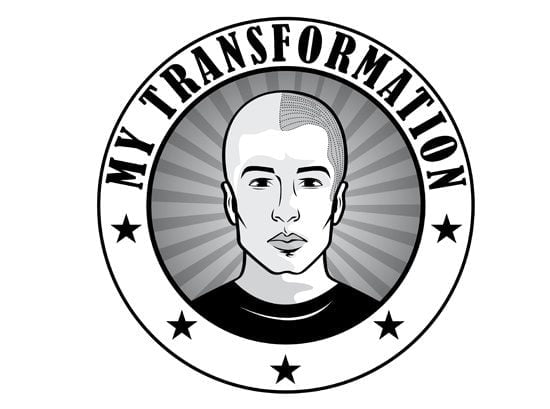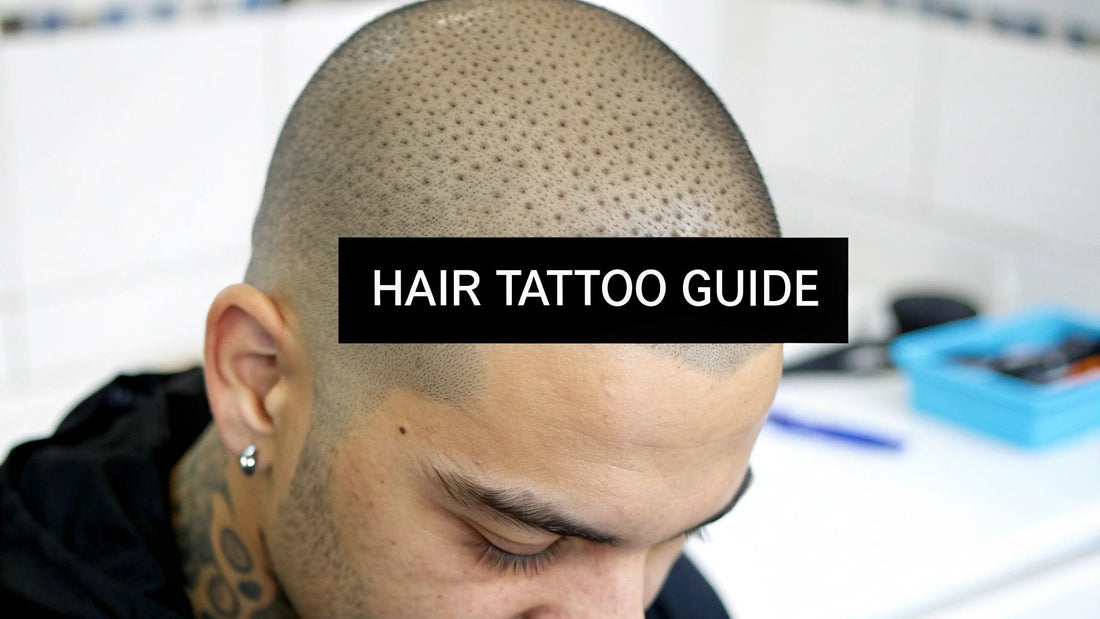
Hair Tattoo on Head An Australian Guide to SMP
Share
A hair tattoo on head, known in the industry as Scalp Micropigmentation (or SMP), is a sophisticated, non-surgical cosmetic treatment that masterfully creates the illusion of real hair follicles on the scalp. It's a game-changer for people dealing with hair loss.
The technique involves using specialised microneedles to carefully deposit tiny dots of pigment, which perfectly mimic the look of a short buzz cut or cleverly add the appearance of density to thinning hair.
So, What Exactly Is a Hair Tattoo?
When you first hear "hair tattoo," it’s easy to picture a standard body tattoo—bold lines, dramatic shading, maybe a dragon or two. But that couldn't be further from the truth. Scalp Micropigmentation is a highly refined cosmetic procedure, worlds apart from traditional tattooing.
Think of it less like drawing a picture and more like pointillism, the art technique where a detailed image is built from thousands of tiny, individual dots. A skilled SMP artist does exactly that, but on your scalp.
The whole point of a hair tattoo on head is to replicate the look of your own natural hair follicles. By strategically placing these micro-dots of pigment into the very top layer of the skin, a practitioner can:
- Build a complete "shaved head" look for men who are bald or have a receding hairline.
- Create the illusion of thickness and density in areas where hair is thinning out.
- Expertly camouflage scars from hair transplant surgery, accidents, or other procedures.
This process is fundamentally different from getting a regular tattoo. The needles are much finer, the pigment doesn't go as deep, and the skill set is entirely focused on achieving a soft, natural, and utterly convincing result.
How Is It Different From a Regular Tattoo?
Getting your head around what sets SMP apart is key. A common mistake is thinking any tattoo artist can just pick up the tools and do it, but the equipment, techniques, and goals are completely different. With SMP, the aim isn't to create a bold piece of art; it's to create an undetectable illusion that restores a natural-looking hairline.
This journey from consultation to the final look is a structured, multi-session process, as you can see below.
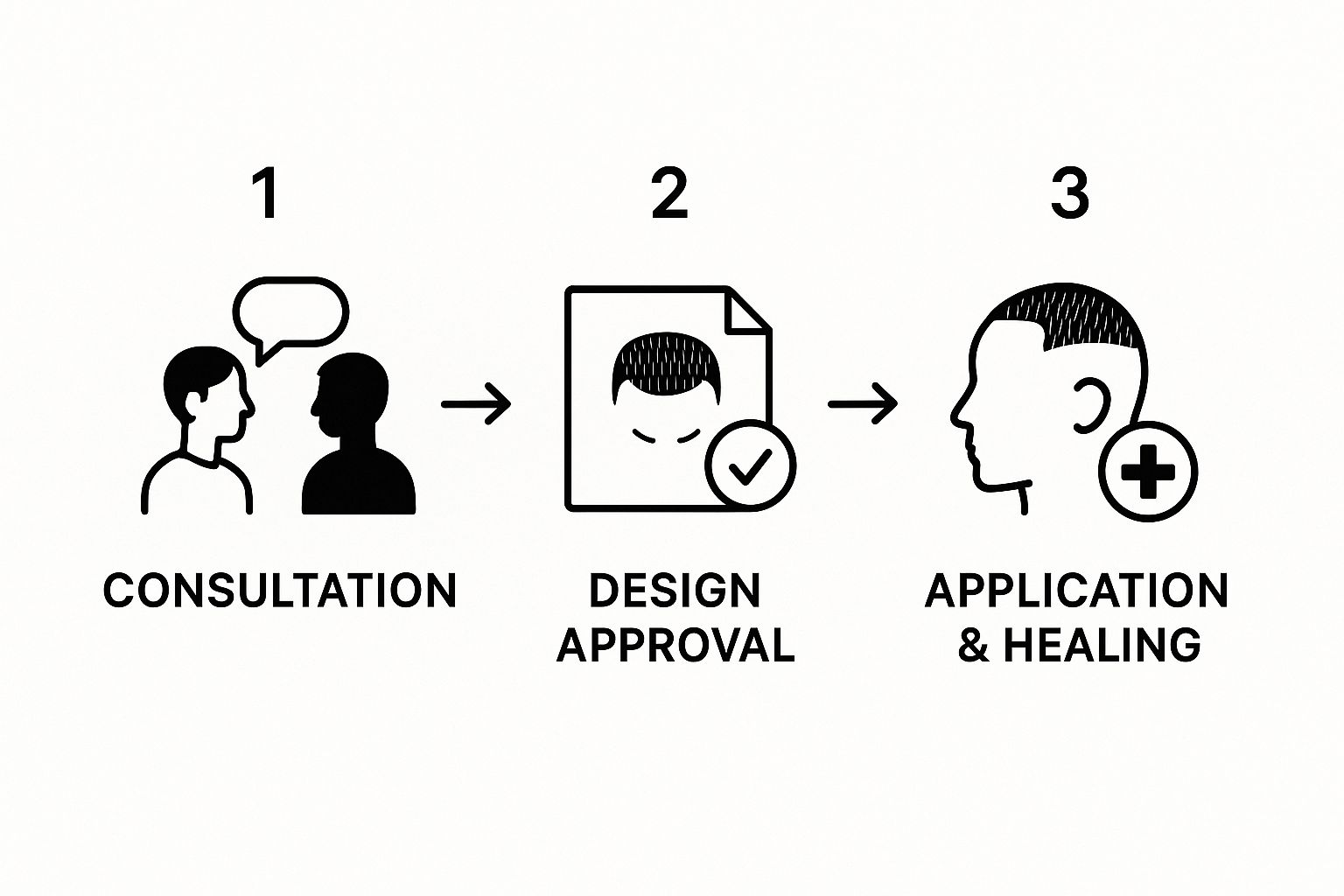
As the image shows, this isn't a one-and-done appointment. It's a carefully planned procedure designed to deliver a customised and realistic outcome.
The growing popularity of SMP in Australia really speaks to how well it works. Over the last decade, it’s become a go-to solution for hair loss. It typically lasts 3-5 years before you might need a touch-up, and its success has led to thousands of practitioners across the country. It's important to note, however, that the industry standard for a true expert is someone with at least five years of experience or over 500 completed treatments. This level of experience is crucial for achieving the artistry needed for a natural look and avoiding the pitfalls of amateur work.
The real magic of SMP is in the details. It’s all about perfectly matching the pigment to your skin tone, varying the dot size and placement, and crafting a soft, feathered hairline. These are the nuances that separate an incredible result from an obvious one.
To make these differences crystal clear, let's break them down.
Hair Tattoo (SMP) vs Traditional Tattoo At a Glance
The table below gives you a quick side-by-side look at how scalp micropigmentation and a standard body tattoo stack up against each other. It’s a great way to see just how distinct these two procedures really are.
| Feature | Hair Tattoo (SMP) | Traditional Body Tattoo |
|---|---|---|
| Purpose | To create the illusion of hair follicles and density. | Artistic expression, symbolic meaning, or decoration. |
| Needle Size | Microneedles (much finer and smaller). | Larger needle groupings for lining and shading. |
| Pigment Depth | Epidermis (upper layer of skin), approx. 1.5-2mm deep. | Dermis (deeper skin layer), approx. 2-3mm deep. |
| Pigment Type | Specialised carbon-based pigment that resists colour change. | Inks with various compounds; can change colour over time. |
| Technique | Pointillism; layering tiny dots to build up density. | Lining, shading, and colouring with broad strokes. |
| Longevity | Semi-permanent, lasting 3-5 years before a touch-up is needed. | Permanent, though it may fade and blur over decades. |
| Pain Level | Generally considered less painful; often described as a 2-4 out of 10. | Varies greatly, but can be significantly more painful. |
Hopefully, that clears up any confusion! While both use needles and pigment, their application and end goal are on completely different planets.
For an even more detailed explanation, you can explore our in-depth guide on what scalp micropigmentation is and get all the specifics.
A Step-by-Step Look at the SMP Procedure
Getting a hair tattoo on your head isn't a one-and-done appointment. It's a carefully planned journey, a bit like an artist building up layers of paint to create depth and realism. The whole process is broken down into distinct stages, making sure the final look is as natural and seamless as possible.
Let's walk through what you can expect from your very first chat with a practitioner to the final, finished result.
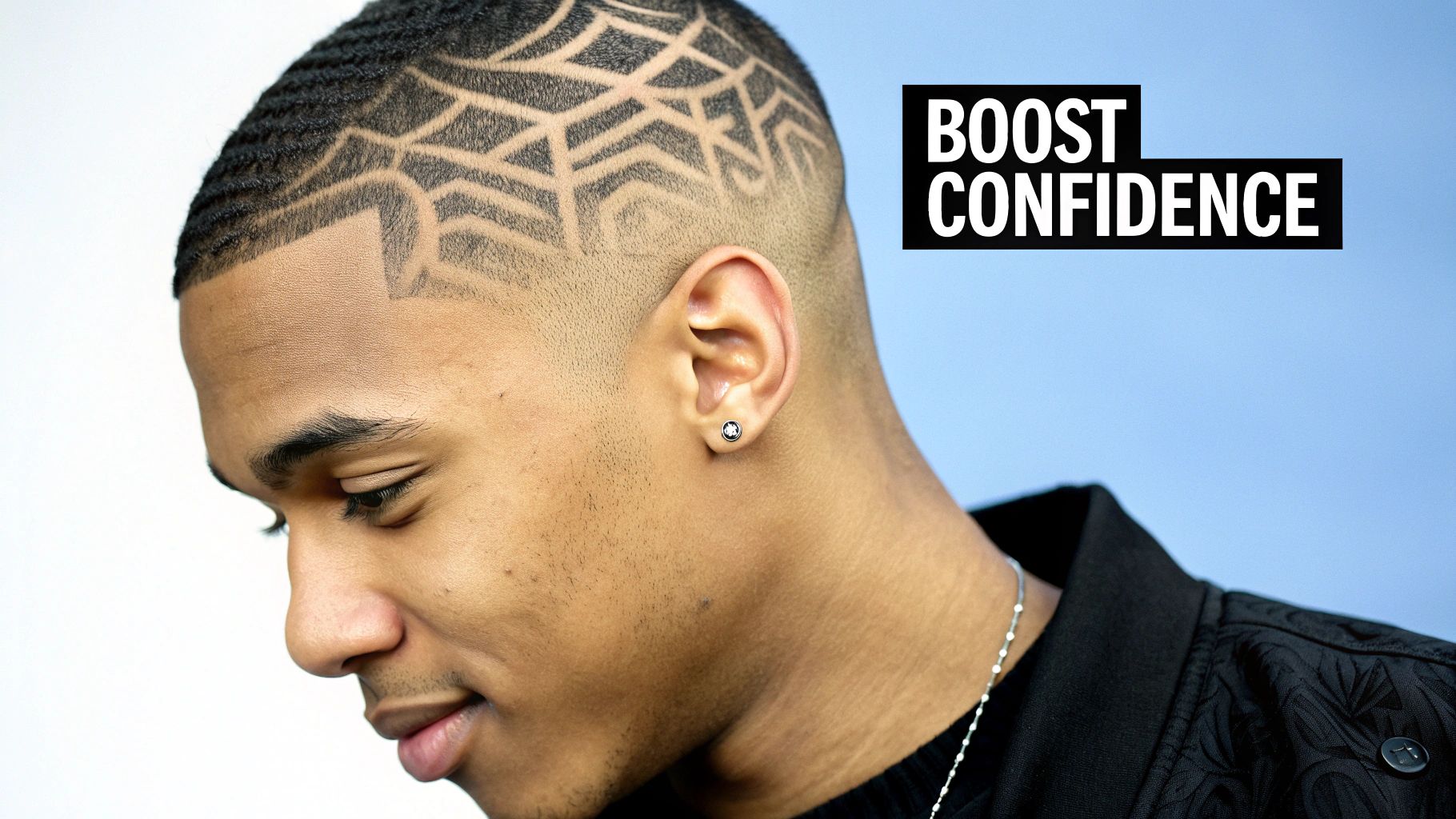
Each session is a deliberate step, methodically building upon the last to create an incredibly realistic illusion of hair density.
Stage 1: The Initial Consultation
Honestly, this first meeting is the most crucial part of the whole experience. It's where you and your practitioner get on the same page, turning your ideas into a concrete plan. Think of it as the blueprinting phase for your new look.
During this chat, you'll cover a few key things:
- Your Goals: What are you hoping to achieve? Maybe you want a sharp, defined "edge-up" hairline, or perhaps something softer and more receded for a natural feel. You might be adding density to thinning hair or going for the full buzz-cut look.
- Hairline Design: Your practitioner will sketch a potential hairline right onto your scalp. Don't worry, it's not permanent yet! It’s a template you both agree on, taking into account your facial structure, age, and personal style before any needles are involved.
- Colour Matching: This is where the real artistry comes in. The practitioner will carefully mix pigments to create a shade that perfectly matches your existing hair colour and complements your skin tone. Getting this right is what makes the final result totally undetectable.
This consultation is all about setting realistic expectations and making sure you feel 100% confident moving forward. It’s the perfect time to ask every single question you can think of.
Stage 2: The Treatment Sessions
The real work of scalp micropigmentation happens over two to four sessions, usually spaced about 10-14 days apart. This isn't done to drag things out; this multi-session approach is the secret to achieving a believable illusion of density.
It's a bit like painting a wall. One coat looks patchy and thin, but each additional coat builds up colour and coverage. SMP works the same way, layering thousands of tiny pigment dots to create a 3D effect that mimics real hair follicles.
Each appointment typically lasts between two and four hours, depending on how much area needs to be covered. The practitioner uses a specialised machine with ultra-fine needles to deposit pigment into the very top layer of your scalp. Most people describe the feeling as a minor irritation rather than outright pain, often ranking it a 2-4 out of 10 on the pain scale.
The real magic of SMP lies in the layering. Your first session creates the foundation. The next sessions build on that, adding density, subtle shading, and texture. This creates a lifelike appearance that looks just like a real head of closely shaved hair.
This gradual approach also gives your scalp the time it needs to heal between appointments, which is vital for making sure the pigment settles properly and the final result is top-notch.
Stage 3: Healing And Aftercare
After each session, the healing begins. Your practitioner will give you a clear set of aftercare instructions—and following them is non-negotiable if you want to protect your investment and get the best outcome.
The downtime between sessions is pretty short, usually around a week or so. During this time, a few simple rules apply.
Your main aftercare duties will include:
- Keeping it Dry: You must keep your scalp away from water for the first few days. That means no washing your hair, no swimming, and no saunas.
- No Heavy Sweating: Hold off on any intense workouts that will make you sweat heavily. Sweat can push the fresh pigment out before it has a chance to settle.
- Sun Protection: Fresh pigment and direct sunlight are not friends. Keep your scalp covered with a hat whenever you're outdoors during that initial healing phase.
Sticking to these steps ensures the pigment heals perfectly without any issues. If you want the full rundown, you can learn more about how to prepare for your scalp micropigmentation treatment in our comprehensive guide.
Once your final session is done, long-term care is simple: just focus on keeping your scalp moisturised and protected from the sun to keep your new look sharp for years to come.
Who Is a Hair Tattoo Actually For?
Trying to figure out if a hair tattoo is the right call for you? It really boils down to your type of hair loss and the look you're going for. While it's a remarkably flexible solution, it truly shines for a few key groups of people. Let's break down who gets the absolute best results from Scalp Micropigmentation (SMP).
The classic candidate, and the one most people picture, is the person ready to rock a sharp, clean-shaven buzz-cut. This works especially well for men with more advanced hair loss, like a receding hairline or significant balding on top.
Instead of fighting a losing battle, SMP lets you take control with a bold, new style. It creates a powerful illusion of a full head of hair that's been intentionally buzzed down.
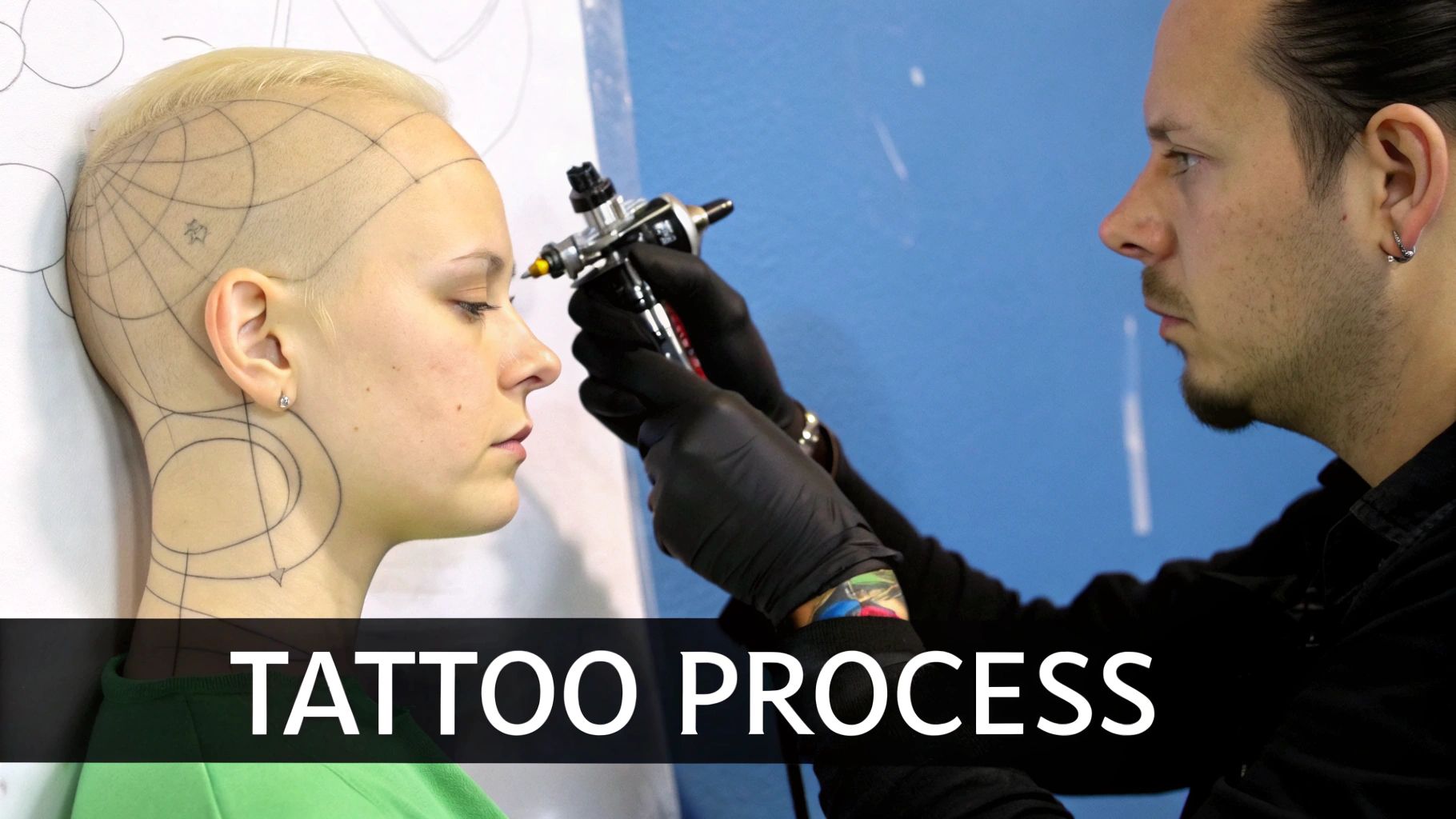
Men with Male Pattern Baldness
For guys experiencing male pattern baldness, SMP is nothing short of a game-changer. We often refer to the Norwood scale to map out the stages of hair loss, and honestly, SMP works across the board. Whether you’re a Norwood 2 with a bit of recession or a Norwood 7 with very little hair left, a hair tattoo can be tailored to rebuild a natural-looking hairline.
The magic is in the details. Thousands of tiny pigment deposits are layered to fill in the balding areas, creating a strong, defined frame for your face. For anyone wanting a permanent, no-fuss look without going under the knife, this is often the perfect answer.
SMP doesn't just cover baldness; it artfully recreates what was lost. A great practitioner will design a hairline that fits your age and face shape, making sure the result looks incredibly natural and believable.
People with Thinning Hair
You don’t need to be completely bald to see amazing results from a hair tattoo. In fact, one of its best uses is creating the look of more density in thinning hair. It's a fantastic option for both men and women who still have hair but are starting to see too much scalp showing through.
The technician works between your existing hairs, carefully adding pigment dots to the scalp. This simple trick dials down the contrast between your skin and your hair, which instantly makes your hair look thicker and fuller.
This approach is brilliant for:
- Diffuse Thinning: This is common for women, where hair thins out all over the top of the scalp.
- Crown Thinning: That classic bald spot at the back of the head that many men deal with.
- General Low Density: A great fix for anyone who just feels their hair lacks that robust, dense appearance.
Camouflaging Scars and Imperfections
A hair tattoo on the head is also a master of disguise. Plenty of people have scalp scars from accidents, surgery, or even old hair transplant procedures (like the well-known FUT strip scars). These marks can be really obvious, especially if you like to keep your hair short.
SMP can make these scars virtually invisible. A skilled artist meticulously deposits pigment into and around the scar tissue, blending it seamlessly with the surrounding follicles. The scar essentially vanishes into the 'hair'. This technique is a massive confidence-booster, creating a clean, uniform look across the whole scalp.
Understanding Hair Tattoo Costs in Australia
One of the first questions on everyone's mind when they look into a hair tattoo on head is, "So, what's the damage?" It's a fair question, but there's no simple, one-size-fits-all answer. The cost of scalp micropigmentation is tailored to you. Think of it less like buying a product and more like commissioning a custom piece of art—the final price really depends on the detail and scale of the work involved.
Breaking down the key variables that shape your final quote will help you understand why prices can vary so much from person to person. It puts you in the driver's seat, allowing you to review quotes with confidence and make a smart financial choice.
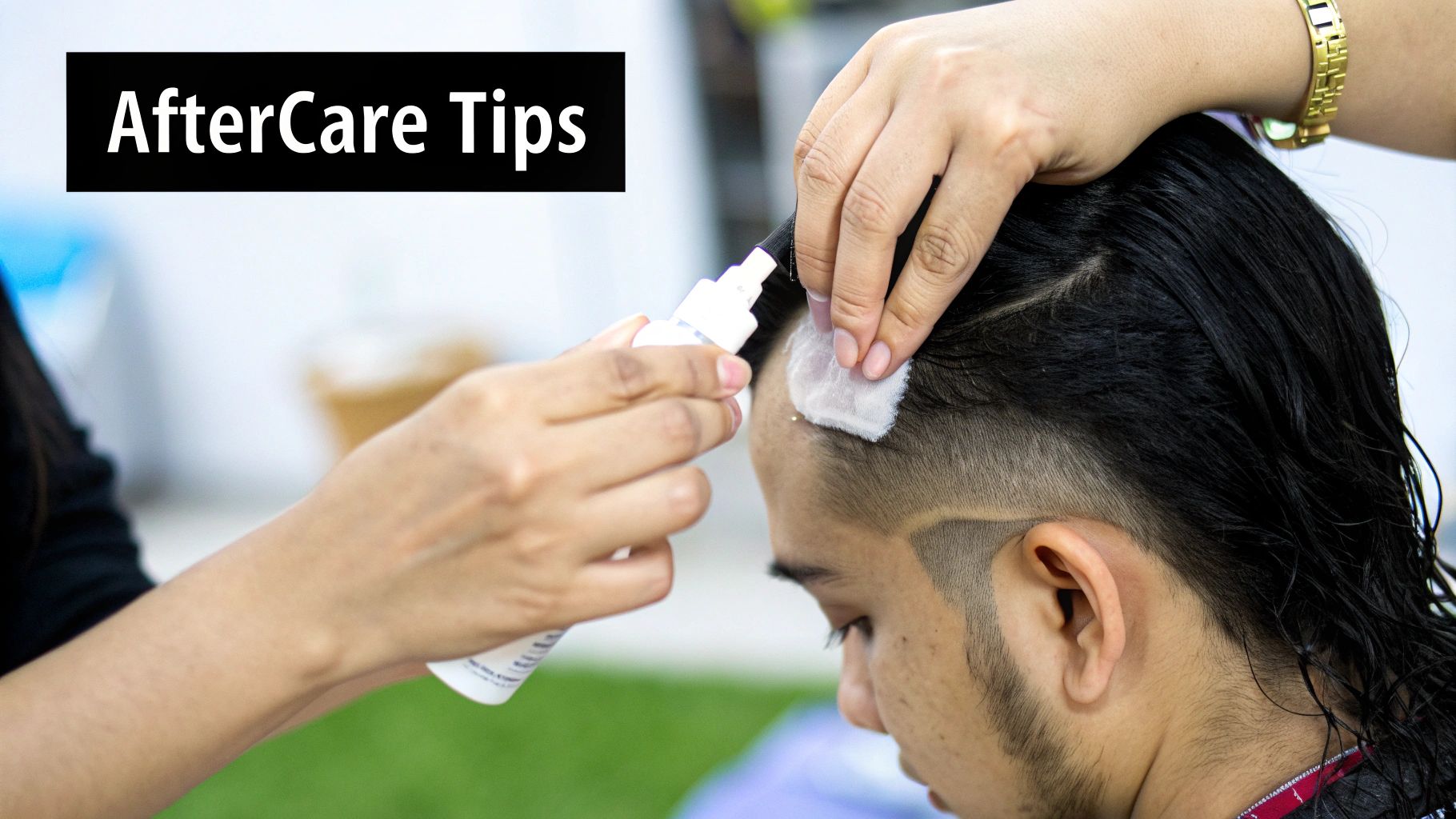
Key Factors That Influence The Price
Your scalp micropigmentation (SMP) journey is a personal one, and the cost reflects that. A few different elements come together to determine the total investment needed to get the look you're after.
Here's what clinics look at when preparing a quote:
- Extent of Hair Loss: This is the big one. Someone at a Norwood 2 stage, who just needs a little touch-up on their hairline, will have a much smaller bill than someone at a Norwood 7, who needs their entire scalp covered. More scalp to cover means more time in the chair and more pigment used.
- Size of Treatment Area: It's not always about the Norwood scale. You might just want to camouflage a scar from a past hair transplant or add some density to a thinning crown. These smaller, more targeted jobs are naturally less expensive.
- Practitioner Experience: Let's be honest, you're paying for skill. A seasoned artist with a killer portfolio and a long list of happy clients is going to charge more. You're investing in their expertise and artistry, which is what guarantees a result that looks natural and not like a tattoo.
The Role of Clinic Location
Where the clinic is based in Australia also makes a difference. Just like a coffee costs more in the city, the operational costs for a business vary wildly between regions, and this gets factored into the treatment price.
Clinics in the middle of Sydney or Melbourne have higher overheads to cover—think rent, staff wages, and other bills. As a result, their prices tend to be a bit steeper than what you'd find in a smaller city or a regional town. While you might be tempted by a lower price tag elsewhere, always make sure the artist's skill and portfolio are your top priorities.
Estimated Hair Tattoo Costs in Australia by Norwood Scale
To give you a clearer idea of what to expect, the table below outlines some general price ranges based on the Norwood scale for hair loss. Keep in mind, these are just estimates—your final quote will come after a proper consultation.
| Norwood Scale Level | Description of Hair Loss | Estimated Cost Range (AUD) |
|---|---|---|
| Norwood 2-3 | Minor hairline recession or slight thinning at the crown. | $800 - $1,800 |
| Norwood 4-5 | More significant hair loss on the crown and a receding hairline. | $1,800 - $2,800 |
| Norwood 6-7 | Extensive to complete hair loss across the top of the scalp. | $2,800 - $4,000+ |
| Scar Camouflage | Covering scars from FUE/FUT surgery or other injuries (area-dependent). | $500 - $1,500 |
This guide should help you budget, but remember that when you're looking into a hair tattoo, evaluating the key decision-making factors like precision, pain, and cost is essential for making a choice you'll be happy with long-term.
It's also worth remembering that SMP isn't a one-and-done deal.
The price you're quoted will almost always cover the full treatment course, which typically involves 2 to 4 separate sessions. This is what it takes to build up the density gradually for that perfectly natural, layered look.
If you want to dig a bit deeper into the numbers, our detailed guide provides more context on what goes into the cost of scalp micropigmentation. Being well-informed is the best way to start this journey.
Long-Term Care and Maintaining Your Hair Tattoo
Getting a hair tattoo on head is an incredible feeling—it’s a massive confidence boost. But the journey doesn’t stop when you walk out of your last session. To keep that sharp, fresh look for the long haul, you need to think about maintenance. It’s an investment, after all, and you want to protect it.
Proper care really boils down to two stages. First, you've got the immediate aftercare, which is absolutely critical for the healing process. After that, it's all about building a few simple, long-term habits to protect the pigment and keep your scalp healthy. Get this right, and your SMP will look fantastic for years.
The Crucial First Few Days
Listen up, because this part is important. The first 7 to 10 days after each treatment session are where the magic happens. Your scalp is healing, and the tiny pigment deposits are settling into the skin. Whatever your practitioner tells you to do during this time, follow it to the letter.
Your main job is to keep the treated area clean, dry, and away from any kind of irritation.
- Avoid Water and Moisture: For the first four days, your scalp must stay completely dry. That means no showers (at least not on your head), no swimming, and definitely no saunas or steam rooms.
- No Intense Sweating: You'll have to skip the gym for a few days. Sweat can mess with the healing and might even push some of that fresh pigment out before it has a chance to set properly.
- Stay Out of the Sun: Fresh pigment and direct sunlight are not friends. If you have to go outside, wear a loose-fitting hat to shield your scalp. UV rays are notorious for causing premature fading.
Stick to these rules, and you give the pigment the best possible chance to heal perfectly, setting you up for a crisp, even result.
Long-Term Maintenance Essentials
Once your scalp has fully healed, looking after your hair tattoo is surprisingly simple. It's less about strict rules and more about weaving a couple of healthy habits into your daily life. The number one goal? Protect the pigment from things that can make it fade, especially the sun.
Sunscreen is now your best mate. Just like UV rays can dull a regular tattoo, they do the same to the specialised pigment used in SMP.
Protecting your scalp from the sun is the single most effective thing you can do to prolong the life and vibrancy of your hair tattoo. Consistent sun protection is what separates a look that lasts three years from one that lasts five or more.
To keep your SMP looking its absolute best, lock in these key practices:
- Use a High-SPF Sunscreen: Slap on a sunscreen with at least SPF 30+ every single day. Yes, even when it’s cloudy. A matte-finish sunscreen is a great choice because it stops your scalp from looking shiny.
- Keep Your Scalp Moisturised: A healthy, hydrated scalp holds pigment much better. A light, non-greasy moisturiser used daily will prevent dryness and flaking, which can make the treatment look dull.
- Gentle Cleansing: Stay away from harsh shampoos loaded with alcohol or sulphates. They can strip moisture from your scalp and, over time, might affect the pigment.
For a deeper dive into keeping your scalp happy, check out these 5 top tips to care for your scalp after SMP.
Scheduling Periodic Touch-Ups
Even with the best care in the world, your hair tattoo will gradually lighten over the years. This is completely normal and expected. The pigment is designed to fade slowly and naturally, not change colour, which is why touch-ups are part of the long-term game plan.
Most guys find they need a refresh session every 3 to 5 years. How soon you'll need one depends on a few things, like your skin type (oilier skin can sometimes mean faster fading), your immune system, and, of course, how much sun your scalp gets.
A touch-up is a straightforward process. Your practitioner simply adds a fresh layer of pigment over the existing work, bringing back the original depth and definition. It’s the key to keeping your hair tattoo on head looking sharp and seamlessly blended for a lifetime.
Common Myths and Potential Risks of SMP
Getting a hair tattoo on head is a big step, and it's smart to look at the full picture. While Scalp Micropigmentation can be a game-changer for so many people, it's not without its risks. Let's cut through the noise, tackle some common myths, and talk about what can go wrong so you can make a decision you're confident in.
Like any procedure that breaks the skin, there’s a small chance of complications. You've got the usual suspects like allergic reactions to the pigment or skin infections, but these are pretty rare. They usually only pop up if the clinic isn't up to scratch or if you slack off on your aftercare. This is why it’s so important to pick a clinic that’s obsessed with hygiene—think single-use needles and a properly sterilised setup.
Honestly, the biggest risk isn't infection; it's a shoddy job. An inexperienced artist can leave you with an unnatural result. We're talking pigment dots that are too big and look like plugs, a colour that's a poor match for your skin tone, or a hairline that looks like it was drawn on with a marker. Do your homework. Scrutinise portfolios and read reviews—it's the only way to protect yourself.
Debunking Common Misconceptions
There’s a lot of chatter out there about SMP, and frankly, a lot of it is just plain wrong. Let's set the record straight on a few of the most persistent myths.
Myth 1: It Looks Obviously Fake
This is the number one fear for most people, and it’s completely understandable. But here’s the thing: a masterfully done hair tattoo is virtually undetectable. A true artist uses several shades of pigment and carefully varies the size and density of the dots. This creates a clever 3D effect that perfectly mimics the look of real hair follicles. When it's done right, people can stand right next to you and not know it isn't a real buzz cut.
Myth 2: It Will Stop My Hair from Growing Back
Absolutely not. The SMP pigment is placed in the upper dermis of the scalp, only about 2mm deep. Your hair follicles are nestled much further down, at around the 4mm mark. The needle never even gets close to them. Your existing hair will continue to grow exactly as it did before.
A hair tattoo is purely a cosmetic touch-up that sits well above the hair follicle. It has zero biological impact on your hair's natural growth cycle, which makes it a safe option even if you still have some hair or are holding out for future regrowth.
Myth 3: The Pain is Unbearable
Pain is subjective, of course, but most of our clients are pleasantly surprised. They usually describe the feeling as a light, annoying pricking sensation—not real pain. On a scale of 1 to 10, most people rate it somewhere between a 2 and a 4. It's generally much less intense than a regular body tattoo because the needles are finer and don't go as deep.
What if I Change My Mind?
It makes sense to wonder what happens if you have second thoughts down the track. While SMP is designed to last for years, it’s not completely irreversible. The pigment will slowly lighten over time, and if you ever decide it's not for you anymore, you’ve got options.
SMP can be removed with a specialised laser. To get a better sense of how that works, you can read our detailed guide on whether scalp micropigmentation can be removed. Knowing there's an exit strategy can give you that extra peace of mind.
Your Hair Tattoo Questions, Answered
Thinking about Scalp Micropigmentation? It's natural to have questions. Let's walk through some of the most common ones we hear, giving you the straightforward answers you need to feel good about your decision.
We'll cover everything from what it feels like to how it looks years down the track.
Is Getting a Hair Tattoo Painful?
Most people are surprised to find it's more of a mild annoyance than real pain. On a scale of 1 to 10, clients usually rate it a 2 to 4.
It’s certainly much more comfortable than getting a regular body tattoo. That's because the specialised needles for SMP only work on the very top layers of your skin. Plus, your practitioner will always apply a numbing cream to your scalp beforehand to make sure you're as comfortable as possible.
Will The Pigment Change Colour?
This is a great question, and a really important one. Traditional tattoo inks can sometimes fade to an odd blue or green colour over the years, but SMP is different. We use a specialised, carbon-based pigment that’s designed to hold its tone.
The pigment used for a hair tattoo on head is built for stability. It won't change colour. What it will do is slowly and gently lighten over several years, which is a perfectly normal part of the process.
This is exactly why we recommend a touch-up session every 3-5 years. It’s a simple way to restore the original depth and keep your look looking sharp and natural.
Can I Still Grow My Hair?
Yes, absolutely. SMP doesn't affect your hair follicles or your ability to grow hair at all.
Think of it this way: the pigment is placed in the upper dermis of your skin, about 2mm deep. Your hair follicles live much deeper, at around the 4mm mark. The procedure simply doesn't go deep enough to interfere with them. In fact, many clients get SMP specifically to create an illusion of thickness beneath their existing, thinning hair.
What Happens if I Go Grey?
A good SMP artist always thinks ahead. They don't just use a flat black ink. Instead, they work with carefully diluted pigments to create softer, greyscale shades that blend beautifully with salt-and-pepper or completely grey hair.
Even when your hair turns grey, the root itself often stays a little darker. The tiny SMP dots are designed to replicate this, so the whole look stays natural and cohesive as you age. Your artist can also easily adjust the pigment during future touch-ups to match any changes.
At My Transformation, we are dedicated to providing life-changing hair loss solutions that restore confidence. If you're ready to explore how SMP can work for you, visit us at https://www.mytransformation.com.au.
